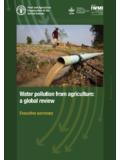Transcription of Town and Country Planning Act 1990 Appeal by …
1 1 Town and Country Planning Act 1990 appeal by fairfield elsenham (Ltd) Site at Land North East Of elsenham , elsenham , cm22 6AA Appeal ref APP/C1570/A/14/2213025 _____ CLOSING SUBMISSIONS On behalf of the Joint Parish Councils ( Appeal B) _____ 1. Appeal B should be dismissed. There is no pressing need for additional housing in the District. The Council is clearly able to demonstrate a supply of deliverable housing land which comfortably exceeds 5 years. The proposed development will cause Planning harm in a number of respects, not least in respect of lack of sustainability and severe impact on the highways network and highway safety. In the circumstances of this case, the proposal should be dismissed due to the clear conflict with the adopted development plan.
2 Even if it were determined that the higher paragraph 14 NPPF test were to apply, which we say is not engaged, it has been clearly demonstrated that the harm significantly and demonstrably outweighs the benefits. 2. These closing submissions are organised into three distinct main sections; the statutory duty and the Planning balance; five year housing land supply and transport and highways. The Statutory Duty and the Planning Balance 3. The starting point in the determination of the Appeal must be the statutory duty to determine the Appeal in accordance with the development plan unless material considerations indicate otherwise ( (6) Planning and Compulsory Purchase Act 2004 and Town and Country Planning Act 1990).
3 The NPPF does not and could not depart from this. 2 4. For the purposes of this Appeal , the statutory development plan comprises the saved policies of the UDC Local Plan 2005. There is no dispute (Mr Copsey, PC xx) that the Appeal proposal is in clear conflict with saved policies S3 and S7 of the Plan. The effect of those policies is that the development would be outside the settlement boundary of elsenham and within the countryside, where policy S7 says that only development that needs to be in the countryside and is appropriate to a rural area should be permitted. This large urban development is clearly not development that needs a countryside location, is inappropriate to a rural area and so is contrary to policies S3 and S7.
4 5. As set out below, it is also clearly contrary to policy GEN1 due to its inadequate road access and impact on the highway network. Further, it would be contrary to policy ENV5 (and para 112 of the NPPF) due to its take of some of the best and most versatile agricultural land BMV (33 43 ha). Whilst it is true that much of the District is made up of grades 2 and 3 agricultural land, there is no evidence of how much of the latter is BMV within the definition in Annex 2 of the NPPF. This is because there is no evidence of how much is grade 3a (which is within the definition) and grade 3b (which is not). There is also no assessment of the Appeal site in this respect. Therefore, as accepted by PC, it simply cannot be said that the site is constituted of poorer quality agricultural land than other sites in the District.
5 The loss of BMV is a clear disadvantage of the proposal. 6. It is evident from all these conflicts that if the Appeal were determined in accordance with the adopted development plan, as is required by statute, there could be no real doubting that it would be dismissed and refused permission. It is only if there were material considerations clearly indicating otherwise that a grant of permission could be justified. 7. There are no material considerations indicating a different outcome. Whilst the emerging Local Plan shows the Appeal site as part of a proposed allocation, this cannot be accorded any significant weight. Neither the allocation, nor the soundness of the whole strategy of the Plan have yet been independently examined and there are of course very significant unresolved objections to the elsenham allocation.
6 In such circumstances, paragraph 216 of the NPPF is clear: little or no weight is to be given to policies which have very significant unresolved objections. Even PC accepts that only limited weight can be accorded to the emerging plan. 8. Another material consideration that could potentially detract from the development plan outcome is government policy as a whole, found in the NPPF. However, the circumstances of this case are such that the NPPF does not pull in a different direction from the development plan. The NPPF acknowledges that it does not and cannot change the statutory priority that is given to the development plan (NPPF para 12). It is also clear that due weight should be given 3 to relevant policies in existing plans according to their degree of consistency with the framework (NPPF para 215).
7 There is no material inconsistency between the applicable development plan policies and the framework. Policy S7 seeks to protect the countryside from unnecessary development. PC accepted that this is consistent with the NPPF s acknowledgement of the intrinsic character and beauty of the countryside (para 17 5th bullet). He also accepted that the fact that S7 includes different wording does not make it inconsistent and he accepted that policy S7 includes similar flexibility to that included in the NPPF. 9. Further, the NPPF recognises the importance of a plan-led system that provides a practical framework within which decisions on Planning applications can be made with a high degree of predictability and efficiency (NPPF para 17 1st bullet).
8 That system is only to be disturbed in specific circumstances, such as where a local Planning authority cannot demonstrate a five year supply of housing land (NPPF para 49 and para 14). Those circumstances do not arise here. 10. Whilst the Appellant (and specifically, PC) assert that the weighted balance in paragraph 14 is triggered and applies even in the presence of a five year housing land supply, that argument cannot reasonably be sustained. PC accepted that the development plan is not absent or silent, and relies only on an assertion that it is out of date . However, he accepted that it cannot be considered out of date simply because it is time expired (in the sense of the plan period having ended).
9 If it could be considered out of date for that reason alone, the effect of paragraph 14 would be to override the statutory status of all time expired plans, something which could not be intended and which would not be lawful. 11. PC sought to rely on an argument that the adopted plan s development needs were settled a number of years ago. However, that cannot be an adequate reason for rejecting the development plan as out of date in circumstances where it is determined that objectively assessed, up to date development needs are being met. Such a determination would naturally follow from a conclusion that there is a five year housing land supply. This can also be implied from the fact that, conversely, where there is not a five year housing land supply, paragraph 49 specifically deems policies for the supply of housing as out of date , thus expressly dealing with PC s development needs point.
10 12. Further, where there is a 5 year housing land supply, there is no need to breach the settlement boundaries of the adopted local plan and there is no need to disturb the predictability and efficiency of the plan led system. Accordingly, as in the recent Summer Street Appeal decision dated 15 September 2014 (at paras 30 31) (attached to Ms Hutchinson s, AH s rebuttal proof), policy S7 should be accorded weight, the Appeal should be determined in accordance with it and the weighted balance in paragraph 14 should not apply. 4 13. So, in fact, the NPPF does not contain any indication that the proposal should be determined otherwise than in accordance with the adopted statutory development plan.





